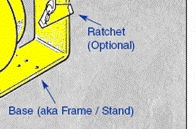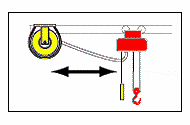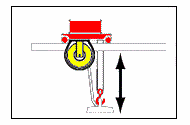Cable Reel
J.Herbert Corporation offers many electrification options for your hoist and crane applications. These include cable reels, conductor bar systems, festoon cable systems, top entry collectors, bottom entry collectors and tag lines to provide power at any AMP to your hoist or crane. We provide all electrification accessories to provide complete hoist electrification and crane electrification.
Conductix, Magnetek , Duct-O-Wire and Harrington Crane are our best sellers. These suppliers provide Flat Cable, Top Entry Collector bars, buss bars, tow bars, clamps, hangers, power feeds C-Track systems, electric cable reels, end stops, pendants, joint assemblies, and series A cable reels.
You can be confident that any hoist you buy from these manufacturers they will meet or exceed the ANSI and OSHA standards and will provide years of service.
Cable reels, also known as electrical cord or power reels, are one of several alternatives for providing power to electric hoists.
Multiple conductor power cable is wrapped around a spool drum, which rotates to payout or retract the necessary length of cable for the application.
The reel can be installed in a fixed position or with a swivel or pivot base to allow it different degrees of rotation and cable payout in various directions.










Additional options include ball stops to limit retraction, cable grips to relieve strain on the cord terminals, guard rails for operator and equipment protection, spool locks to prevent rotation under certain conditions, limit switches, ratchets, and cable guides.
Specialty models can be manufactured for hazardous locations or welding applications.
It is important to note the following:
Cable reels are typically used on short run monorails (less than 100'). Larger reels are available but may not be as cost effective as festooning or conductor bar systems.
It is not recommended to install cable reels with smaller capacity hoists attached to push type/manual trolleys. The spring tension of the reel might cause the hoist and trolley to pull back. It might also add undue strain when trying to maneuver the trolley down the beam.
Cable Reel Selection
In order to select the proper cable reel it is necessary to determine the following:
-
Mechanical Requirements
-
Electrical Requirements
-
Cable Length Requirements
Mechanical Requirements
In what kind of application will the reel be used?
Stretch, Lift, Drag or Retrieve?

Stretch
The cable is "stretched" horizontally without any support. The reel can be stationary or mounted onto moving equipment. Cable is pulled out by the hoist.

Lift
The reel needs to "lift" the cable vertically. The reel is usually stationary. Cable is pulled out by the hoist or by hand (as with a pendant).

Drag
The reel needs to "drag" the cable through supports or along the ground horizontally. The reel is usually stationary. Cable is pulled out by the hoist or by hand.

Retrieve
The reel needs to "retrieve" the cable. The reel is mounted on moving equipment. Cable is pulled out by the machine.
-
In what type of environment will the reel be used? (Indoors, outdoors, corrosive atmosphere, etc.).
-
What is the Duty Cycle? (How often will the reel have to payout and retract?)
-
What is the equipment maximum speed? (Maximum recommended speed is 150' per minute.)
Electrical Requirements
-
How much amperage is the cable reel expected to handle?
-
At what voltage?
-
What will the reel be required to handle: power, control, or communication signals?
-
How many total conductors are required? (Plus an extra for ground).
-
What gauge (AWG) cable is required?
Cable Length Requirements
-
Figure out active length (difference between minimum and maximum operating payout) plus inactive length (cable that always stays out of reel) plus safety wrap (cable that stays on reel at max payout) plus hook up length (cable required for termination a both end).
-
For Stretch applications, also add a sag factor (10% to Active and Inactive lengths).
-
For Drag or Retrieve applications, add the distance between where the cable lays up to spool center line (maximum of 4').
